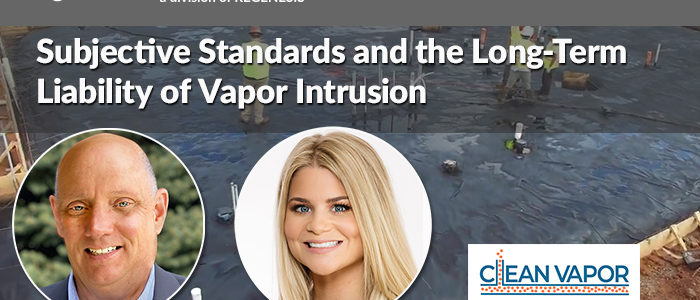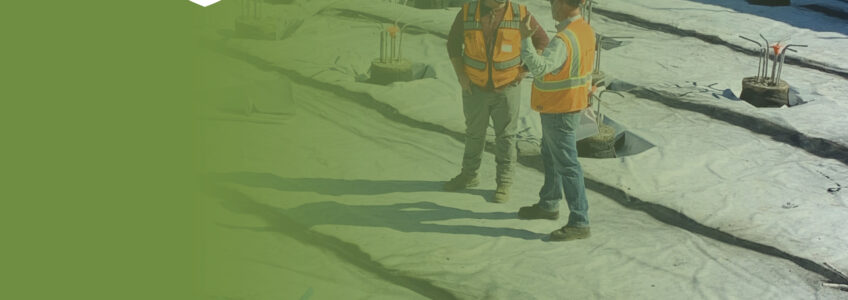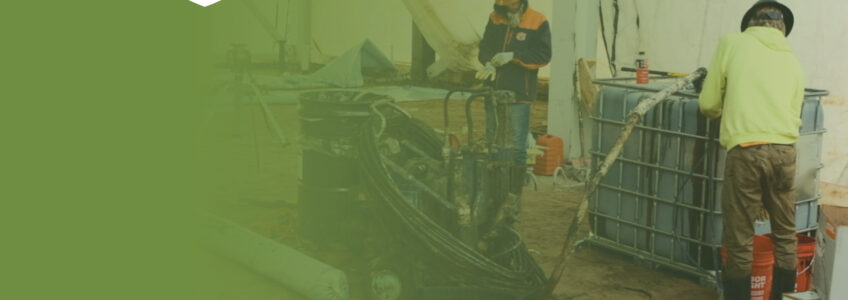Land Science Sheds Light on How Office Worker Migration Trends Intensify Vapor Intrusion Concerns
SAN CLEMENTE, Calif.–(BUSINESS WIRE)–The “new normal” for office workers post-COVID-19 is expected to look very different from today’s landscape, with leading experts projecting a move away from traditional high-rise offices toward new construction of low-rise industrial parks that enable continued social distancing. Land Science, a division of REGENESIS, is actively addressing the increased vapor intrusion risk resulting from the rising trend in new office park construction on brownfields and other environmentally distressed properties—in an aim to mitigate the long-term health risks these contaminants pose to workers.
COVID-19 is Driving a Trend Away from Traditional Office Workspaces
The COVID-19 pandemic resulted in a dramatic shift in workplace geography as workers moved from centralized office locations to home-based offices. Stanford economist Nicholas Bloom, a leading researcher studying the work-from-home trend, notes: “[An] incredible 42 percent of the U.S. labor force is now working from home full time.” Bloom also suggests that new office building construction will be altered post-COVID-19 based on an increased desire for social distancing. He states, “instead of building more office skyscrapers – which has been the dominant theme over the past 40 years – I predict that COVID-19 will dramatically shift the trend to industrial parks with low-rise buildings.”
The predicted shift to new office spaces at former industrial parks matches established construction trends in the residential and mixed-use building sectors. Due to inexpensive land, tax credits and other incentives, redevelopment of these former brownfields into living and retail space has been robust during the past decade.
Increase in Risks to Exposure of Potential Toxic Chemical Vapors
This office worker migration trend will result in a significant increased risk for worker exposure to potentially toxic chemical vapors left behind from past industrial activity. Chemical vapors are formed when substances containing chlorinated solvents, petroleum hydrocarbons or other volatile compounds commonly used in industry are spilled or improperly disposed of. Over time, these chemicals migrate through soil, contaminating groundwater and forming chemical vapor plumes.
Building occupants might be at risk of exposure to indoor air containing these vapors if a building is constructed within a contaminant vapor plume footprint. Inhalation of chemical vapors is often hazardous to human health, even at indoor air concentrations not detected by smell.
Effective Contaminant Vapor Barriers Address Risk
Land Science’s vapor intrusion mitigation systems incorporate the latest technological advances to offer the highest chemical protection available. These advanced systems comprise patented, state-of-the-art materials, including metalized films and nitrile-modified asphalt sealants that offer up to one-hundred times more chemical protection than other vapor intrusion mitigation systems like plastic sheets with taped seams and spray-applied waterproofing “boots.”
While offering the highest level of protection against vapor intrusion, these systems are often easier and faster to install and are priced competitively. Brownfield property developers are rapidly increasing the incorporation of these systems into their building plans as a means to address any potential vapor intrusion risk, known or unknown, and to ensure development stays on schedule.
Preemptive Installation May Be Less Expensive Than Investigation and Monitoring
A vapor mitigation system’s cost is insignificant relative to a new building project, and Land Science’s certified applicators can install these advanced systems quickly without delaying construction.
Comparative cost analyses have shown that it is often less expensive to proactively install a contaminant vapor barrier rather than investigate and monitor whether it is needed. Once installed, these vapor mitigation systems provide a high level of assurance for personal safety. According to the U.S. EPA’s Brownfields Technology Primer: “Incorporating relatively inexpensive mitigation (prevention) techniques into the construction of new buildings, rather than retrofitting them later, will result in significant cost savings and help avoid the occurrence of vapor intrusion in the future.”
ABOUT REGENESIS and LAND SCIENCE: Founded in 1994, REGENESIS is an expert provider of in situ soil, groundwater, and vapor intrusion remediation products and services. Land Science, a division of REGENESIS, offers a full line of vapor intrusion mitigation technologies and is the safe and effective choice for leading engineering, construction, and environmental consulting firms serving a broad range of clients, including developers, insurance companies, manufacturers, municipalities, regulatory agencies, and federal, state and local governments.
©2021 All rights reserved. REGENESIS and PlumeStop, are registered trademarks of Regenesis Bioremediation Products Inc.
Contacts
MEDIA CONTACT:
Leslie Licano, Beyond Fifteen Communications, Inc.
regenesis@beyondfifteen.com; 949.733.8679
December 2020 Land Science Newsletter
|
Subjective Standards and the Long-Term Liability of Vapor Intrusion
Learn the following in this free webinar:
- The evolution of the standards process and solutions toward harmonizing best practices in VMS design
- Best technical merits of state guidance documents as well as integrating standardized practices
- How adopting a framework of best design, mitigation and operation maintenance & monitoring (OM&M) practices could promote transparency in performance, documentation, energy efficiency, and limit health and long-term liability risks
- The industry’s most protective vapor barriers featuring metalized films and nitrile-advanced asphalt latex
In this webinar we were pleased to have as a special guest speaker Tom Hatton, CEO of Clean Vapor LLC. His presentation discussed subjective standards and the long-term liability of vapor intrusion. He was joined by Jordan Knight, Central Region Manager of Land Science, who shared advanced vapor mitigation barrier technologies that can be incorporated into vapor mitigation system (VMS) designs to minimize the long-term liability that often comes with contaminated site redevelopment.
View webinar
Complete the form below to view this free webinar.
TerraShield Assists Development in Sacramento’s Downtown
Project snapshot highlights:
- Innovative Vapor Barrier Chosen for Electrical Substation as Safest, Most Cost-Effective Solution
- Timely and Cost-Efficient Application Allows Development to Proceed
- Innovative, Nitrile-Advanced Core Quickly and Effectively Seals Utility Penetrations and Terminations
Sacramento is experiencing a renaissance, with a metropolitan area that has grown to include over 2.5 million people. As the city continues to grow and change, the downtown Sacramento area is evolving rapidly with many new buildings in various construction stages. Roebbelen Contracting, Inc., a leading Northern California based contracting and construction firm, was engaged by their client to build an electrical substation in the downtown area. The substation development included the need for a contaminant vapor barrier system due to past heavy industrial land usage. Keeping pace with the latest vapor mitigation innovations, the environmental consultant, working with their client, recommended Land Science’s TerraShield® based on it having demonstrated 100 times more chemical resistance than other vapor barrier systems.
TerraShield Installed at New, State-of-the-Art Aquatic Research and Education Center
Project snapshot highlights:
- Volatile Organic Contaminants
- State-of-the-Art Research and Education Center
- 8,500 Square Feet Installed
In Michigan’s Upper Peninsula, Lake Superior State University (LSSU) is constructing a $14.5 million expansion that will house its state-of-the-art Center for Freshwater Research and Education (CFRE). When completed, the CFRE building will include freshwater testing laboratories, classrooms, an aquatic learning center, and an expansion of LSSU’s internationally-renowned fish hatchery. The new building is being constructed in an area of past spills of volatile organic contaminants (VOCs), posing a potential vapor intrusion risk. Assessing the risk and the options to mitigate it, the project team opted to install TerraShield® with a TerraVent® passive venting system. Terrashield was determined to be the vapor mitigation solution providing the highest level of protection at a competitive cost and offering superior installation efficiencies as compared to alternative vapor intrusion mitigation approaches.






 In Sacramento, CA, Roebbelen Contracting Inc. was engaged by their client to build an electrical substation in the downtown area. Due to extensive industrial use at the site historically, heavy subsurface contamination posed a significant vapor intrusion risk. As a result, the development was in need of an effective vapor mitigation system as part of the construction project. The environmental consultant at the site recommended TerraShield from Land Science. TerraShield offers the highest level of chemical resistance because of its nitrile asphalt latex spray-applied core and metalized film, providing the highest level of protection from contaminant vapors available on the market today.
In Sacramento, CA, Roebbelen Contracting Inc. was engaged by their client to build an electrical substation in the downtown area. Due to extensive industrial use at the site historically, heavy subsurface contamination posed a significant vapor intrusion risk. As a result, the development was in need of an effective vapor mitigation system as part of the construction project. The environmental consultant at the site recommended TerraShield from Land Science. TerraShield offers the highest level of chemical resistance because of its nitrile asphalt latex spray-applied core and metalized film, providing the highest level of protection from contaminant vapors available on the market today.









 Nitra-Seal® is a new advanced nitrile composite barrier system. It represents an update/improvement on current vapor barrier systems. An acknowledged weakness in these systems is in the penetration and perimeter termination locations, where spray-applied core material composed of Styrene-Butadiene Rubber (SBR) latex/asphalt is used. Nitra-Seal offers a substantial upgrade as it employs a more chemically resistant nitrile latex instead of the more susceptible SBR latex. Nitra-Seal is a composite system creating the ideal blend between constructability and chemical resistance by using both high density polyethylene (HDPE) and nitrile-advanced, spray-applied asphalt core. Learn more and download the product brochure below.
Nitra-Seal® is a new advanced nitrile composite barrier system. It represents an update/improvement on current vapor barrier systems. An acknowledged weakness in these systems is in the penetration and perimeter termination locations, where spray-applied core material composed of Styrene-Butadiene Rubber (SBR) latex/asphalt is used. Nitra-Seal offers a substantial upgrade as it employs a more chemically resistant nitrile latex instead of the more susceptible SBR latex. Nitra-Seal is a composite system creating the ideal blend between constructability and chemical resistance by using both high density polyethylene (HDPE) and nitrile-advanced, spray-applied asphalt core. Learn more and download the product brochure below.









